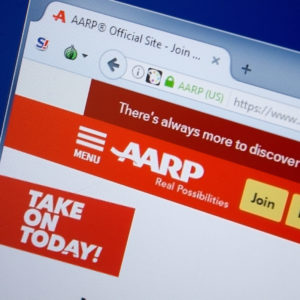To some, it might seem odd that an organization that claims to advocate for seniors has as its largest partner a business reportedly under investigation by the Justice Department for its Medicare billing practices. But unfortunately, such conflicts are par for the course for AARP.
As I outline in a new report for American Commitment, the organization formerly known as the American Association of Retired Persons has become incredibly compromised over the past two decades by its financial entanglements. The title of an investigative expose, which refers to AARP’s “billion-dollar bounty,” says it all. Rather than acting in the best interests of seniors, the organization has spent years seeking to slap its name and logo onto all manner of products—and, in so doing, has effectively sold its soul to the highest bidder.
In 2021, mere weeks after AARP announced a marketing partnership with a group of medical clinics, that same group announced it was under federal investigation into its marketing tactics, including possible violations of the federal False Claims Act. However, that questionable relationship has nothing on AARP’s longtime partnership with UnitedHealth Group, the nation’s largest insurer.
As I outline in the report, since 2007, UnitedHealth has contributed approximately $9 billion—yes, billion with a “B”—in revenue to AARP’s bottom line. While critics claim that AARP “is in the insurance business,” the reality is, in some ways, far worse. Whereas insurers have to assume risk and could suffer financial losses, AARP bears no financial risk and can just watch the money from UnitedHealth come pouring in.
One of AARP’s largest sources of income—arguably more than it generates in membership dues—comes from selling Medigap supplemental insurance products. For these policies, AARP collects a 4.95 percent “royalty fee” out of every premium dollar. In other words, the organization has an in-built financial incentive to get seniors to buy insurance they may not want or need, because for every additional premium dollar seniors pay, AARP makes more money.
Its unsavory business practices, which it does not affirmatively disclose to seniors buying products from AARP, aren’t the only way in which the organization places its bottom line over the interests of its members. With regard to both Obamacare in 2010 and the misnamed “Inflation Reduction Act” of 2022, AARP endorsed legislative proposals that combined to divert roughly $1 trillion from the Medicare program to pay for other government spending.
Why did AARP support these massive raids on Medicare? As accounts from the passage of Obamacare showed, and more recent polling from American Commitment confirmed, seniors did not and do not take kindly to the thought of funds being redirected from their health care coverage to fund other government programs—or the AARP’s endorsement of same.
One explanation for the organization’s endorsement of legislation many of its members opposed lies in the fact that both Obamacare and the IRA provided massive subsidies to big insurance companies like UnitedHealth. It also didn’t hurt that Obamacare exempted AARP’s lucrative Medigap insurance policies from its new regulatory regime, allowing AARP to keep imposing restrictions on Medigap applicants with pre-existing conditions or disabilities.
As one Washington analyst noted about AARP, “It’s hard to know whether they’re advocating for their business interests or for the seniors that they are supposed to represent.” Another official who ran the Medicare program under President Clinton added that “there ought to be accountability and visibility” about AARP’s financial conflicts and questionable conduct. Here’s hoping Congress takes up that cause, sooner rather than later.





